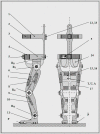Mechatronic Wearable Exoskeletons for Bionic Bipedal Standing and Walking: A New Synthetic Approach
- PMID: 27746711
- PMCID: PMC5040717
- DOI: 10.3389/fnins.2016.00343
Mechatronic Wearable Exoskeletons for Bionic Bipedal Standing and Walking: A New Synthetic Approach
Abstract
During the last few years, interest has been growing to mechatronic and robotic technologies utilized in wearable powered exoskeletons that assist standing and walking. The available literature includes single-case reports, clinical studies conducted in small groups of subjects, and several recent systematic reviews. These publications have fulfilled promotional and marketing objectives but have not yet resulted in a fully optimized, practical wearable exoskeleton. Here we evaluate the progress and future directions in this field from a joint perspective of health professionals, manufacturers, and consumers. We describe the taxonomy of existing technologies and highlight the main improvements needed for the development and functional optimization of the practical exoskeletons.
Keywords: bionic walk assistance; bipedal standing; mechatronic; models; portable/wearable exoskeletons.
Figures






Similar articles
-
Mobile Mechatronic/Robotic Orthotic Devices to Assist-Rehabilitate Neuromotor Impairments in the Upper Limb: A Systematic and Synthetic Review.Front Neurosci. 2018 Sep 5;12:577. doi: 10.3389/fnins.2018.00577. eCollection 2018. Front Neurosci. 2018. PMID: 30233289 Free PMC article.
-
Wearable robotic exoskeleton for overground gait training in sub-acute and chronic hemiparetic stroke patients: preliminary results.Eur J Phys Rehabil Med. 2017 Oct;53(5):676-684. doi: 10.23736/S1973-9087.17.04591-9. Epub 2017 Jan 24. Eur J Phys Rehabil Med. 2017. PMID: 28118698
-
The Effectiveness and Safety of Exoskeletons as Assistive and Rehabilitation Devices in the Treatment of Neurologic Gait Disorders in Patients with Spinal Cord Injury: A Systematic Review.Global Spine J. 2016 Dec;6(8):822-841. doi: 10.1055/s-0036-1593805. Epub 2016 Nov 3. Global Spine J. 2016. PMID: 27853668 Free PMC article.
-
Clinical effectiveness and safety of powered exoskeleton-assisted walking in patients with spinal cord injury: systematic review with meta-analysis.Med Devices (Auckl). 2016 Mar 22;9:455-66. doi: 10.2147/MDER.S103102. eCollection 2016. Med Devices (Auckl). 2016. PMID: 27042146 Free PMC article. Review.
-
Powered Exoskeletons for Walking Assistance in Persons with Central Nervous System Injuries: A Narrative Review.PM R. 2017 Jan;9(1):46-62. doi: 10.1016/j.pmrj.2016.07.534. Epub 2016 Aug 24. PM R. 2017. PMID: 27565639 Review.
Cited by
-
Lower Limb Exoskeleton Sensors: State-of-the-Art.Sensors (Basel). 2022 Nov 23;22(23):9091. doi: 10.3390/s22239091. Sensors (Basel). 2022. PMID: 36501804 Free PMC article. Review.
-
Design Advancements toward a Wearable Pediatric Robotic Knee Exoskeleton for Overground Gait Rehabilitation.Proc IEEE RAS EMBS Int Conf Biomed Robot Biomechatron. 2018 Aug;2018:37-42. doi: 10.1109/biorob.2018.8487195. Epub 2018 Oct 11. Proc IEEE RAS EMBS Int Conf Biomed Robot Biomechatron. 2018. PMID: 37600973 Free PMC article.
-
Mobile Mechatronic/Robotic Orthotic Devices to Assist-Rehabilitate Neuromotor Impairments in the Upper Limb: A Systematic and Synthetic Review.Front Neurosci. 2018 Sep 5;12:577. doi: 10.3389/fnins.2018.00577. eCollection 2018. Front Neurosci. 2018. PMID: 30233289 Free PMC article.
-
Evaluation of Spatiotemporal Patterns of the Spinal Muscle Coordination Output during Walking in the Exoskeleton.Sensors (Basel). 2022 Jul 30;22(15):5708. doi: 10.3390/s22155708. Sensors (Basel). 2022. PMID: 35957264 Free PMC article.
-
Weight Bearing Over-ground Stepping in an Exoskeleton with Non-invasive Spinal Cord Neuromodulation after Motor Complete Paraplegia.Front Neurosci. 2017 Jun 8;11:333. doi: 10.3389/fnins.2017.00333. eCollection 2017. Front Neurosci. 2017. PMID: 28642680 Free PMC article.
References
Publication types
LinkOut - more resources
Full Text Sources
Other Literature Sources

